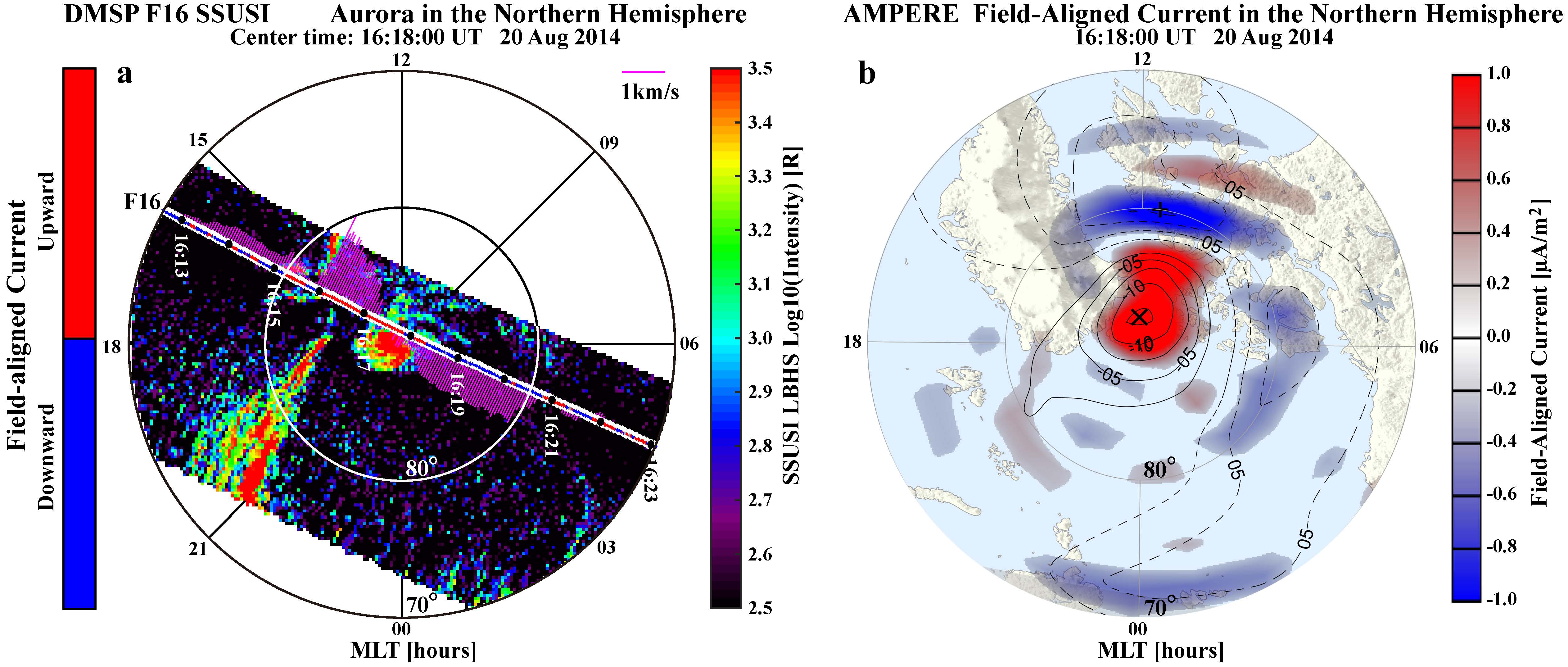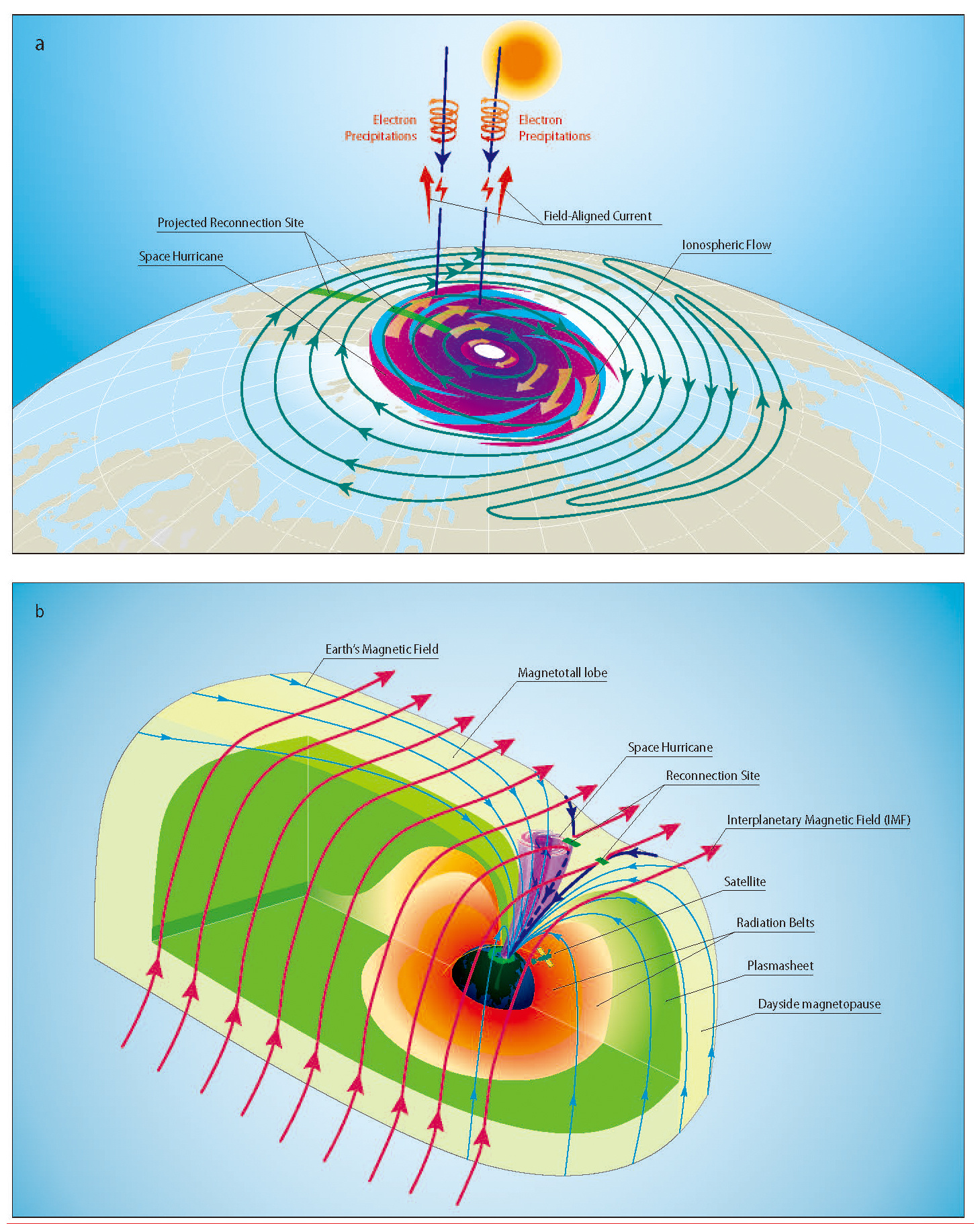A Space Hurricane over the Earth’s Polar Ionosphere
Published in Astronomy


Hurricanes often cause loss of life and property through high winds and flooding resulting from the coastal storm surge of the ocean and the torrential rains. They are characterized by a low-pressure center (hurricane eye), strong winds and flow shears, and a spiral arrangement of towering clouds with heavy rains. In space, astronomers have spotted hurricanes on Mars, and Saturn, and Jupiter, which are similar to terrestrial hurricanes in the low atmosphere. There are also solar gases swirling in monstrous formations deep within the sun's atmosphere, called solar tornadoes with widths of several Earth radii (RE). However, hurricanes have not been reported in the upper atmosphere of the planets in our heliosphere.
This challenge deeply attracted me, because a hurricane is clearly associated with strong energy and mass transportation, so if there is a hurricane in Earth’s upper atmosphere, it must be violent and efficiently transfer solar wind/magnetosphere energy and momentum into the Earth’s ionosphere. Can we find hurricanes in the upper atmosphere (ionosphere and magnetosphere) in any planet of our heliosphere?
In order to answer this question, I lead an international team of researchers to do series of studies, and we found a huge and long-lasting (about 8 hours) cyclone-like auroral spot (diameter over 1000 km) with multiple arms and a trend of anti-clockwise rotation around the north magnetic pole from four DMSP satellites observations (see Fig. 2a). This cyclone-like auroral spot is also associated with 1) a spot-like strong upward FAC (see Fig. 2b, with sometimes a FAC hole developed in the center), 2) zero horizontal flow near its center (the hurricane eye) as well as strong flow shears around the edges, 3) ion upflows, 4) enhanced electron temperature (about 1000 K enhancement), 5) a negative-to-positive bipolar magnetic structure (implying a circular magnetic field perturbation), 6) electron inverted-V acceleration to above 10 keV, and 7) large and rapid deposition of energy and flux into the polar ionosphere (much stronger precipitating electron energy flux than that during typical quiet and substorm conditions, and comparable to that during super storms). These features are very similar with the hurricane in low atmosphere, thus, we analogically names it as “space hurricane”.

Fig. 2. An example of aurora and FACs observations in the polar region of the Northern Hemisphere. a. Aurora in the Lyman–Birge–Hopfield short-band (LBHS) band (wavelength of 140-150 nm), the measured cross-track horizontal ion flows shown in mauve drift vectors perpendicular to the orbit, and the sign of the FACs shown in red and blue color along the satellite track. The aurora is observed by the SSUSI instrument on board the DMSP F16 satellite, the ion flow is measured by the special sensor for ions, electrons, and scintillation (SSIES) and the FAC is calculated from the magnetic field measurement of special sensor microwave (SSM) instrument. These instruments are all on board the DMSP F16 satellite. b. The distribution map of the FACs and potential of AMPERE magnetic perturbation data products derived from the Iridium satellites constellation.
These indicate that the space hurricane leads to large and rapid deposition of energy and flux into the polar ionosphere during an otherwise extremely quiet geomagnetic condition, suggesting that current geomagnetic activity indicators do not properly represent the dramatic activity within space hurricanes, which are located further poleward than geomagnetic index observatories.
After detail analyzing of the observations from DMSP satellites and AMPERE FAC, comparing with high-resolution simulations from a data driven 3D global magnetohydrodynamics (MHD) code (piecewise parabolic method with a Lagrangian remap to MHD (PPMLR-MHD)), we found that the magnetic reconnection will steadily occur at high latitude lobe region for an extended period of time during a several hour period of stable northward IMF and very low solar wind density and speed. After the lobe reconnection, the newly reconnected open field lines are draped by the solar wind to move dawnward and then tailward from the morning side to the afternoon side in the high-latitude lobe region and will gradually return to their previous positions and participate in a new cycle of magnetic reconnection. Their evolution will eventually form a cyclone-shaped funnel of FAC with multiple FAC arms and a clockwise circulation of the plasma flow, due to the pressure gradient and magnetic stresses on both sides of the funnel for completing the FACs and the flow shear and curvature of the circular flow. Inside the funnel, a corkscrew magnetic field forms with circular flow and upward FACs, which accelerate electrons that precipitate into the ionosphere and create the auroral spot with multiple arms (see Fig. 3). This means that the space hurricane opens a rapid energy transfer channel from space to the ionosphere and thermosphere.

Fig. 3. Schematic of the space hurricane and its formation mechanism during an extremely quiet geomagnetic condition with northward IMF and a dominant By component. a. Schematic of a space hurricane in the northern polar ionosphere. The magenta cyclone-shape auroral spot with brown thick arrows of circular ionospheric flows represents the space hurricane with a light green background showing the downward FACs. Convection streamlines are in blue with green thick crossed bars that shows the projected magnetic reconnection sites at the dayside magnetopause around equatorward and tailward (lobe) boundary of the cusp. The vertical dark blue lines represent the Earth’s magnetic field lines with electron precipitations and FACs. The sun is on the top representing the polar ionosphere is under sunlight conditions during the interval of interest. b. Schematic of the 3-D magnetosphere when a space hurricane happened. Different color shadings represent different regions of the magnetosphere. The shaded magenta funnel shows the space hurricane in the magnetosphere. Red, black and blue curves with arrows are the interplanetary magnetic field lines, Earth’s magnetic field lines, and newly reconnected Earth’s magnetic field lines. The green thick bars represent the reconnection sites. The yellow curve with a satellite icon shows the satellite orbit. In this case, magnetopause reconnection can take place at the dayside magnetopause around equatorward and tailward (lobe) boundary of the cusp. Due to a steady high-latitude lobe reconnection, a funnel (space hurricane) formed just poleward of the cusp region (Fig. 3b), and a large ionospheric convection lobe-cell with strong circular horizontal plasma flow inside the normal afternoon convection cell (Fig. 3a). (Credit: Illustration by Dr. Qing-He Zhang)
This study suggests that there are still existing local intense geomagnetic disturbance and energy depositions which is comparable to that during super storms. This will update our understanding of the coupling process of solar wind, magnetosphere and ionosphere under extremely quiet geomagnetic conditions. In additional, the space hurricane will lead to important space weather effects like increased satellite drag, disturbances in High Frequency (HF) radio communications, and increased errors in over-the-horizon radar location, satellite navigation and communication systems
The full article is accessible via this link: https://www.nature.com/articles/s41467-021-21459-y
Follow the Topic
-
Nature Communications

An open access, multidisciplinary journal dedicated to publishing high-quality research in all areas of the biological, health, physical, chemical and Earth sciences.
Related Collections
With Collections, you can get published faster and increase your visibility.
Women's Health
Publishing Model: Hybrid
Deadline: Ongoing
Advances in neurodegenerative diseases
Publishing Model: Hybrid
Deadline: Dec 24, 2025



Please sign in or register for FREE
If you are a registered user on Research Communities by Springer Nature, please sign in